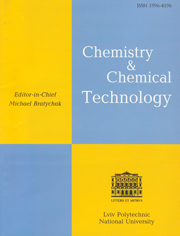Композити з деревного борошна: отримання та дослідження
| Attachment | Size |
|---|---|
| 78.5 KB |
Keywords:
[1] Pizzi, A.; Papadopoulos, A.N.; Policardi, F. Wood Composites and Their Polymer Binders. Polymers 2020, 12, 1115. https://doi.org/10.3390/polym12051115
[2] Faruk, O.; Bledzki, A.K.; Matuana, L.M. Microcellular Foamed Wood-Plastic Composites by Different Processes: A Review. Macromol. Mater. Eng. 2007, 292, 113–127. https://doi.org/10.1002/mame.200600406
[3] Guo, G.; Rizvi, G.M.; Park, C.B.; Lin, W.S. Critical Processing Temperature in the Manufacture of Fine-Celled Plastic/Wood-Fiber Composites Foams. J. Appl. Polym. Sci. 2004, 91, 621–629. https://doi.org/10.1002/app.13193
[4] Zimmermann, M.V.G.; Turella, T.C.; Santana, R.M.C.; Zattera, A.J. The Influence of Wood Flour Particle Size and Content on the Rheological, Physical, Mechanical and Morphological Properties of EVA/Wood Cellular Composites. Mater. Des. 2014, 57, 660–666. https://doi.org/10.1016/j.matdes.2014.01.010
[5] Zhang, S.; Rodrigue, D.; Riedl, B. Preparation and Morphology of Polypropylene/Wood Flour Composite Foam via Extrusion. Polym. Comp. 2005, 26, 731–738. https://doi.org/10.1002/pc.20143
[6] Kumar, V.; Sinha, S.; Saini, M.S.; Kanungo, B.K. Effect of Process Parameters on Mechanical Properties of Rice Husk Polypropylene Composites. Int. Polym. Process 2010, 24, 311–314. https://doi.org/10.3139/217.2369
[7] Kumar, V.; Sinha, S.; Saini, M.S.; Kanungo, B.K.; Biswas, P. Rise Husk as Reinforcing Filler in Polypropylene Composites. Rev. Chem. Eng. 2010, 26, 41–53. https://doi.org/10.1515/REVCE.2010.001
[8] Panthapulakkal, S.; Sain, M. Agro-Residue Reinforced High-Density Polyethylene Composites: Fiber Characterization and Analysis of Composite Properties. Compos. Part A: Appl. Sci. Manuf. 2007, 38, 1445–1454. https://doi.org/10.1016/j.compositesa.2007.01.015
[9] Zweifel, H.; Maier, R.D.; Schiller, M. Plastics additives handbook, 6th ed; Hanser Publications: Munich, Germany, 2008.
[10] Kumar, V.; Tyagi, L.; Sinha, S. Wood Flour – reinforced Plastic Composites: A Review. Rev. Chem. Eng. 2011, 27, 253–264. https://doi.org/10.1515/REVCE.2011.006
[11] Bukia, T.; Utiashvili, M.; Tsiskarishvili, M.; Jalalishvili, S.; Gogolashvili, A.; Tatrishvili, T.; Petriashvili, G. Synthesis of Some Azo Dyes Based on 2,3,3-Trimethyl-3H-Indolenine. Chem. Chem. Technol. 2023, 17, 549–556. https://doi.org/10.23939/chcht17.03.549
[12] Mukbaniani, O.; Tatrishvili, T.; Kvnikadze, N.; Bukia, T.; Pirtskheliani, N.; Makharadze, T.; Petriashvili, G. Bamboo-Containing Composites with Environmentally Friendly Binders. Chem. Chem. Technol. 2023, 17, 807–819. https://doi.org/10.23939/chcht17.04.807
[13] Petriashvili, G.; Chubinidze, K.; Tatrishvili, T.; Kalandia, E.; Petriashvili, A.; Chubinidze M. Light-Stimulated Lowering of Glucose Concentration in a Dextrose Solution Mediated By Merocyanine Molecules. Materiali In Tehnologije 2023, 57, 119–125. https://doi.org/10.17222/mit.2022.639
[14] Demchuk, Y.; Gunka, V.; Pyshyev, S.; Sidun, Y.; Hrynchuk, Y.; Kucinska-Lipka, J.; Bratychak, M. Slurry Surfacing Mixed on the Basis of Bitumen Modified with Phenol-Cresol-Formaldehyde Resin. Chem. Chem. Technol. 2020, 14, 251–256. https://doi.org/10.23939/chcht14.02.251
[15] Gunka, V.; Sidun, Y.; Poliak, O.; Demchuk, Y.; Prysiazhnyi, Y.; Hrynchuk, Y.; Drapak, I.; Astakhova, O. Production of Bitumen Modified with Low-Molecular Organic Compounds from Petroleum Residues. 9. Stone Mastic Asphalt Using Formaldehyde Modified Tars. Chem. Chem. Technol. 2023, 17, 916–922. https://doi.org/10.23939/chcht17.04.916
[16] Liu, C.; Tanaka, Y.; Fujimoto Y. Viscosity Transient Phenomenon during Drop Impact Testing and Its Simple Dynamics Model. World J. Mech. 2015, 5, 33–41. https://doi.org/10.4236/wjm.2015.53004
[17] Shapakidze, E.; Avaliani, M.; Nadirashvili, M.; Maisuradze, V.; Gejadze, I.; Petriashvili, T. Synthesis and Study of Properties of Geopolymer Materials Developed Using Local Natural Raw Materials and Industrial Waste. Chem. Chem. Technol. 2023, 17, 711–718. https://doi.org/10.23939/chcht17.04.711
[18] Rowell, R. M. Chemical Modification of Wood. Forest Products Abstracts 1983, 6, 363–382.
[19] Makharadze, T.; Makharadze, G. Investigation of the Complex Formation Process of Lead (II) with Natural Macromolecular Organic Substances (Fulvic Acids) by the Solubility and Gel Chromatographic Methods. Chem. Chem. Technol. 2023, 17, 740–747.
https://doi.org/10.23939/chcht17.04.740
[20] Demchuk, Y.; Donchenko, M.; Astakhova, O.; Gunka, V.; Drapak, I.; Sulyma, M.; Palianytsia, L.; Bratychak, M. Effect of Bisphenol-Formaldehyde Resin on Physico-Mechanical Properties of Road Bitumen. Chem. Chem. Technol. 2024, 18, 23–29. https://doi.org/10.23939/chcht18.01.023
[21] Mukbaniani, O.; Tatrishvili, T.; Kvinikadze, N.; Bukia, T.; Pachulia, Z.; Pirtskheliani, N.; Petriashvili, G. Friedel-Crafts Reaction of Vinyltrimethoxysilane with Styrene and Composite Materials on Their Base. Chem. Chem. Technol. 2023, 17, 325–338. https://doi.org/10.23939/chcht17.02.325
[22] Xu, G.; Wang, L.; Liu, J.; Wu, J. FTIR and XPS Analysis of the Changes in Bamboo Chemical Structure Decayed by White-Rot and Brown-Rot Fungi. J. Appl. Surface Sci. 2013, 280, 799–805. https://doi.org/10.1016/j.apsusc.2013.05.065
[23] Popelka A.; Zavahir, S.; Habib, S. Chapter 2 - Morphology analysis. In Polymer Science and Innovative Applications Materials. Techniques, and Future Developments; 2020; pp 21–68. https://doi.org/10.1016/B978-0-12-816808-0.00002-0
[24] Li, Y. Wood-Polymer Composites. In Advances in Composite Materials - Analysis of Natural and Man-Made Materials; pp. 229–284. http://dx.doi.org/10.5772/17579
[25] Mukbaniani, O.; Tatrishvili, T.; Pachulia, Z.; Londaridze, L.; Pirtskheliani, N. Quantum-Chemical Modeling of Hydrosilylation Reaction of Triethoxysilane to Divinylbenzene. Chem. Chem. Technol. 2022, 16, 499–506. https://doi.org/10.23939/chcht16.04.499
[26] Tao, Z.; Youcai, Z.; Nyankson, E.A. Resource Recovery Technology for Municipal and Rural Solid Waste: Classification, Mechanical Separation, Recycling, and Transfer; Elsevier Inc., 2023. https://doi.org/10.1016/B978-0-323-98978-7.00025-7
[27] Tatrishvili, T.; Mukbaniani, O.; Kvnikadze, N. Chikhladze, S. Eco-Friendly Bamboo-Based Composites. Chem. Chem. Technol. 2024, 18, 44–56. https://doi.org/10.23939/chcht18.01.044
[28] Petriashvili, G.; Chanishvili, A.; Ponjavidze, N.; Chubinidze, K.; Tatrishvili, T.; Kalandia, E.; Petriashvili, A.; Makharadze, T. Crystal Smectic G Phase Retarder for the Real-Time Spatial-Temporal Modulation of Optical Information. Chem. Chem. Technol. 2023, 17, 758–765. https://doi.org/10.23939/chcht17.04.758
[29] Monteiro, S.N.; Calado, V.; Rodriguez, R.J.S.; Margem, F.M. Thermogravimetric Stability of Polymer Composites Reinforced with Less Common Lignocellulosic Fibers – An Overview. J. Mater. Res. Tecnol. 2012, 1, 117–126. https://doi.org/10.1016/S2238-7854(12)70021-2












